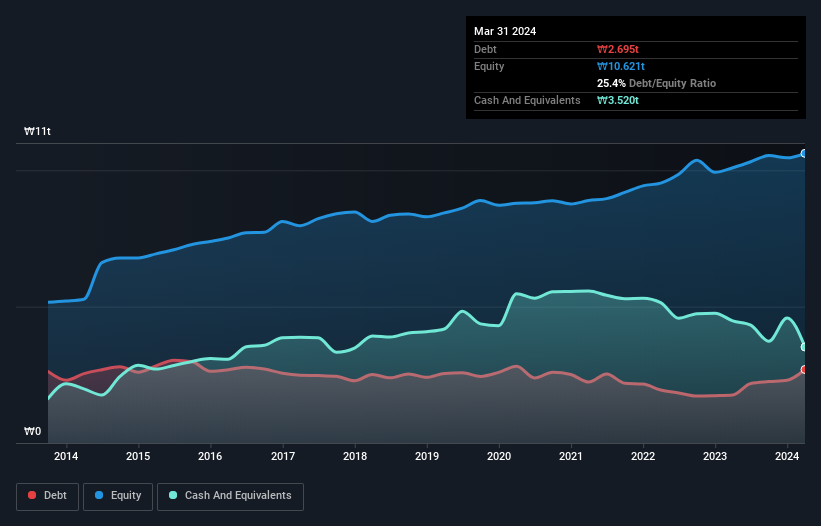- South Korea
- /
- Construction
- /
- KOSE:A000720
These 4 Measures Indicate That Hyundai Engineering & ConstructionLtd (KRX:000720) Is Using Debt Safely

Some say volatility, rather than debt, is the best way to think about risk as an investor, but Warren Buffett famously said that 'Volatility is far from synonymous with risk.' It's only natural to consider a company's balance sheet when you examine how risky it is, since debt is often involved when a business collapses. Importantly, Hyundai Engineering & Construction Co.,Ltd. (KRX:000720) does carry debt. But is this debt a concern to shareholders?
When Is Debt Dangerous?
Generally speaking, debt only becomes a real problem when a company can't easily pay it off, either by raising capital or with its own cash flow. Ultimately, if the company can't fulfill its legal obligations to repay debt, shareholders could walk away with nothing. However, a more common (but still painful) scenario is that it has to raise new equity capital at a low price, thus permanently diluting shareholders. Of course, the upside of debt is that it often represents cheap capital, especially when it replaces dilution in a company with the ability to reinvest at high rates of return. The first thing to do when considering how much debt a business uses is to look at its cash and debt together.
See our latest analysis for Hyundai Engineering & ConstructionLtd
What Is Hyundai Engineering & ConstructionLtd's Debt?
As you can see below, at the end of March 2024, Hyundai Engineering & ConstructionLtd had ₩2.69t of debt, up from ₩1.76t a year ago. Click the image for more detail. But on the other hand it also has ₩3.52t in cash, leading to a ₩824.8b net cash position.

How Strong Is Hyundai Engineering & ConstructionLtd's Balance Sheet?
We can see from the most recent balance sheet that Hyundai Engineering & ConstructionLtd had liabilities of ₩11t falling due within a year, and liabilities of ₩3.09t due beyond that. On the other hand, it had cash of ₩3.52t and ₩12t worth of receivables due within a year. So it actually has ₩1.49t more liquid assets than total liabilities.
This excess liquidity is a great indication that Hyundai Engineering & ConstructionLtd's balance sheet is almost as strong as Fort Knox. With this in mind one could posit that its balance sheet means the company is able to handle some adversity. Simply put, the fact that Hyundai Engineering & ConstructionLtd has more cash than debt is arguably a good indication that it can manage its debt safely.
In addition to that, we're happy to report that Hyundai Engineering & ConstructionLtd has boosted its EBIT by 65%, thus reducing the spectre of future debt repayments. When analysing debt levels, the balance sheet is the obvious place to start. But ultimately the future profitability of the business will decide if Hyundai Engineering & ConstructionLtd can strengthen its balance sheet over time. So if you want to see what the professionals think, you might find this free report on analyst profit forecasts to be interesting.
Finally, while the tax-man may adore accounting profits, lenders only accept cold hard cash. Hyundai Engineering & ConstructionLtd may have net cash on the balance sheet, but it is still interesting to look at how well the business converts its earnings before interest and tax (EBIT) to free cash flow, because that will influence both its need for, and its capacity to manage debt. During the last three years, Hyundai Engineering & ConstructionLtd burned a lot of cash. While that may be a result of expenditure for growth, it does make the debt far more risky.
Summing Up
While we empathize with investors who find debt concerning, you should keep in mind that Hyundai Engineering & ConstructionLtd has net cash of ₩824.8b, as well as more liquid assets than liabilities. And we liked the look of last year's 65% year-on-year EBIT growth. So we don't think Hyundai Engineering & ConstructionLtd's use of debt is risky. The balance sheet is clearly the area to focus on when you are analysing debt. But ultimately, every company can contain risks that exist outside of the balance sheet. For example, we've discovered 2 warning signs for Hyundai Engineering & ConstructionLtd (1 is significant!) that you should be aware of before investing here.
If you're interested in investing in businesses that can grow profits without the burden of debt, then check out this free list of growing businesses that have net cash on the balance sheet.
Valuation is complex, but we're here to simplify it.
Discover if Hyundai Engineering & ConstructionLtd might be undervalued or overvalued with our detailed analysis, featuring fair value estimates, potential risks, dividends, insider trades, and its financial condition.
Access Free AnalysisHave feedback on this article? Concerned about the content? Get in touch with us directly. Alternatively, email editorial-team (at) simplywallst.com.
This article by Simply Wall St is general in nature. We provide commentary based on historical data and analyst forecasts only using an unbiased methodology and our articles are not intended to be financial advice. It does not constitute a recommendation to buy or sell any stock, and does not take account of your objectives, or your financial situation. We aim to bring you long-term focused analysis driven by fundamental data. Note that our analysis may not factor in the latest price-sensitive company announcements or qualitative material. Simply Wall St has no position in any stocks mentioned.
Have feedback on this article? Concerned about the content? Get in touch with us directly. Alternatively, email editorial-team@simplywallst.com
About KOSE:A000720
Hyundai Engineering & ConstructionLtd
Hyundai Engineering & Construction Co.,Ltd.
Very undervalued with moderate growth potential.


